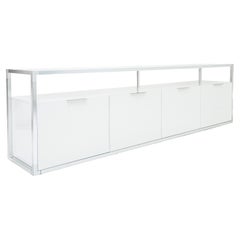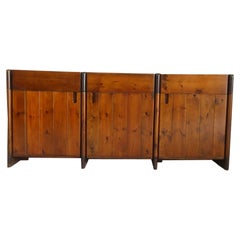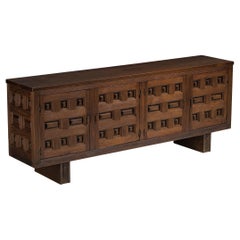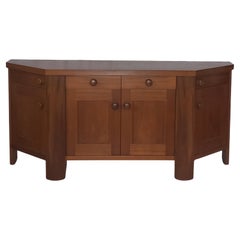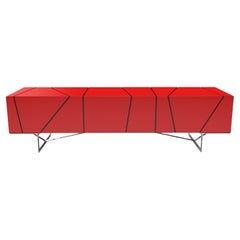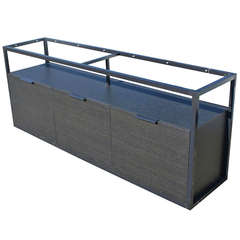Ligne Roset Sideboards
With enduring designs like the immensely plush, Pop art–inspired Togo lounge chair and sofa, Ligne Roset has become synonymous with radical luxury furniture. However, when Antoine Roset (1841–93) started the company in 1860 in the small French town of Oussiat, its focus was on wooden umbrella handles.
In 1892, Ligne Roset’s founder expanded with a property in Montagnieu where he set up a wood-processing factory, eventually expanding into manufacturing chairs. After his death, his wife, Marie-Victorine, took over before his son, Emile Roset, began leading the company in the 1910s.
It wasn’t until after World War II that Antoine’s grandson, Jean Roset, would recognize the need for furniture in settings like schools, hospitals and retirement homes and take inspiration from Scandinavian modern design for functional pieces made primarily from affordable beech.
Under Jean, Ligne Roset supplied quite a few European institutions with beautiful wood furnishings. In the 1970s, he shifted the company’s focus again, this time looking to domestic and residential markets. Around this time, Jean’s two sons, Pierre and Michel, joined the company.
Ligne Roset opened its first store in 1973 with one of the most popular collections being designer Michel Ducaroy’s Togo modular sofa and chairs — classics of contemporary French design that look like oversize bent pillows.
After the success of this initial designer collaboration, Ligne Roset brought on more guest designers over the following decades, including Didier Gomez, Pascal Mourgue, Peter Maly, Pierre Paulin, Inga Sempé and Ronan and Erwan Bouroullec. Paulin’s Elysée sofa and Pumpkin chair — designed in 1971 for Elysée Palace — are among the brand’s most popular pieces. In 1975, the company introduced its Cinna brand, known to collectors for the Sandra sofa designed by Annie Hiéronimus and other alluring seating.
Ligne Roset continues to be run by the Roset family who works on revolutionary furniture in partnership with a variety of collaborators. It has operated in Briord since 1973 where it produces its iconically sleek and innovative pieces.
Find new and vintage Ligne Roset sofas, lounge chairs, tables and other furniture on 1stDibs.
Early 2000s French Minimalist Ligne Roset Sideboards
Aluminum
1970s European Mid-Century Modern Vintage Ligne Roset Sideboards
Pine
1970s Spanish Post-Modern Vintage Ligne Roset Sideboards
Walnut, Pine
1970s Italian Mid-Century Modern Vintage Ligne Roset Sideboards
Walnut
1960s Dutch Mid-Century Modern Vintage Ligne Roset Sideboards
Aluminum
1970s Danish Mid-Century Modern Vintage Ligne Roset Sideboards
Pine
Early 1900s Hungarian Rustic Antique Ligne Roset Sideboards
Glass, Pine
21st Century and Contemporary Mexican Organic Modern Ligne Roset Sideboards
Wood, Hardwood, Walnut
1970s Italian Vintage Ligne Roset Sideboards
Metal, Steel
1960s Italian Mid-Century Modern Vintage Ligne Roset Sideboards
Wood
21st Century and Contemporary French Modern Ligne Roset Sideboards
Metal
1960s Italian Mid-Century Modern Vintage Ligne Roset Sideboards
Walnut
1970s Danish Mid-Century Modern Vintage Ligne Roset Sideboards
Pine
Mid-20th Century Dutch Ligne Roset Sideboards
Chrome
2010s French Modern Ligne Roset Sideboards
Wood, Lacquer
21st Century and Contemporary French Modern Ligne Roset Sideboards
21st Century and Contemporary French Modern Ligne Roset Sideboards
Ligne Roset sideboards for sale on 1stDibs.
Creators Similar to Ligne Roset
- 1stDibs ExpertJune 6, 2024To pronounce Ligne Roset, say LEEN-yuh rose-AY. The first word in the name of the luxury furniture maker is the French word for line, while the second word comes from the name of Antoine Roset, the founder of the company in 1860. Taken together, Ligne Roset means Line Roset, a reference to the fact that it sells a line of furniture created by the Roset family. Shop a collection of Ligne Roset furniture on 1stDibs.
- 1stDibs ExpertNovember 13, 2024To spot a fake Ligne Roset Togo, examine the iconic folds on its cover. Ligne Roset uses plenty of fabric to produce these pleats, so if the folds are shallow or tight, you may be looking at a fake. The next thing to check is the fabric under the sofa. Authentic Togos will have a blue-and-white striped material, so the presence of any other fabric will often indicate a knockoff. The buttons featured in the design are another key detail to consider. If they are domed rather than flat or covered in a material different from the sofa's overall upholstery, you may be examining a replica. When in doubt about the authenticity of a piece, have a certified appraiser or other knowledgeable expert evaluate it. On 1stDibs, explore an assortment of Ligne Roset Togo sofas.
